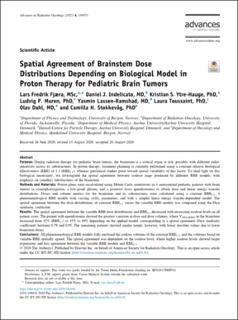| dc.contributor.author | Fjæra, Lars Fredrik | |
| dc.contributor.author | Indelicato, Daniel J. | |
| dc.contributor.author | Ytre-Hauge, Kristian | |
| dc.contributor.author | Muren, Ludvig Paul | |
| dc.contributor.author | Lassen-Ramshad, Yasmin | |
| dc.contributor.author | Toussaint, Laura | |
| dc.contributor.author | Dahl, Olav | |
| dc.contributor.author | Stokkevåg, Camilla Hanquist | |
| dc.date.accessioned | 2021-05-31T11:41:29Z | |
| dc.date.available | 2021-05-31T11:41:29Z | |
| dc.date.created | 2020-10-09T20:30:16Z | |
| dc.date.issued | 2021 | |
| dc.Published | Advances in Radiation Oncology. 2020, 1-9. | |
| dc.identifier.issn | 2452-1094 | |
| dc.identifier.uri | https://hdl.handle.net/11250/2757065 | |
| dc.description.abstract | Purpose
During radiation therapy for pediatric brain tumors, the brainstem is a critical organ at risk, possibly with different radio-sensitivity across its substructures. In proton therapy, treatment planning is currently performed using a constant relative biological effectiveness (RBE) of 1.1 (RBE1.1), whereas preclinical studies point toward spatial variability of this factor. To shed light on this biological uncertainty, we investigated the spatial agreement between isodose maps produced by different RBE models, with emphasis on (smaller) substructures of the brainstem.
Methods and Materials
Proton plans were recalculated using Monte Carlo simulations in 3 anonymized pediatric patients with brain tumors (a craniopharyngioma, a low-grade glioma, and a posterior fossa ependymoma) to obtain dose and linear energy transfer distributions. Doses and volume metrics for the brainstem and its substructures were calculated using a constant RBE1.1, 4 phenomenological RBE models with varying (α/β)x parameters, and with a simpler linear energy transfer-dependent model. The spatial agreement between the dose distributions of constant RBE1.1 versus the variable RBE models was compared using the Dice similarity coefficient.
Results
The spatial agreement between the variable RBE dose distributions and RBE1.1 decreased with increasing isodose levels in all patient cases. The patient with ependymoma showed the greatest variation in dose and dose volumes, where V50Gy(RBE) in the brainstem increased from 32% (RBE1.1) to 35% to 49% depending on the applied model, corresponding to a spatial agreement (Dice similarity coefficient) between 0.79 and 0.95. The remaining patients showed similar trends, however, with lower absolute values due to lower brainstem doses.
Conclusions
All phenomenological RBE models fully enclosed the isodose volumes of the constant RBE1.1, and the volumes based on variable RBE spatially agreed. The spatial agreement was dependent on the isodose level, where higher isodose levels showed larger expansions and less agreement between the variable RBE models and RBE1.1. | en_US |
| dc.language.iso | eng | en_US |
| dc.publisher | Elsevier | en_US |
| dc.rights | Attribution-NonCommercial-NoDerivatives 4.0 Internasjonal | * |
| dc.rights.uri | http://creativecommons.org/licenses/by-nc-nd/4.0/deed.no | * |
| dc.title | Spatial Agreement of Brainstem Dose Distributions Depending on Biological Model in Proton Therapy for Pediatric Brain Tumors | en_US |
| dc.type | Journal article | en_US |
| dc.type | Peer reviewed | en_US |
| dc.description.version | publishedVersion | en_US |
| dc.rights.holder | Copyright 2020 The Author(s). | en_US |
| dc.source.articlenumber | 100551 | en_US |
| cristin.ispublished | true | |
| cristin.fulltext | original | |
| cristin.qualitycode | 1 | |
| dc.identifier.doi | 10.1016/j.adro.2020.08.008 | |
| dc.identifier.cristin | 1838591 | |
| dc.source.journal | Advances in Radiation Oncology | en_US |
| dc.identifier.citation | Advances in Radiation Oncology. 2021, 6 (1), 100551. | en_US |
| dc.source.volume | 6 | en_US |
| dc.source.issue | 1 | en_US |

